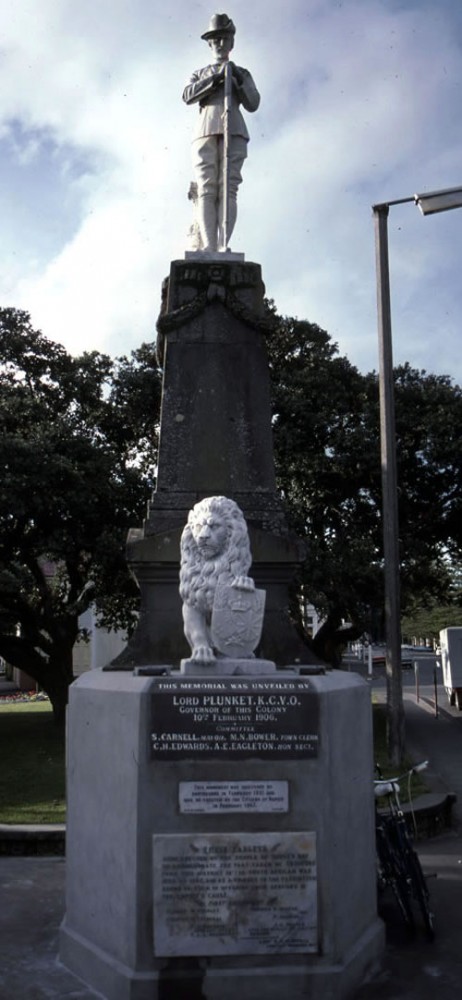Napier South African War memorial

Napier South African War memorial. c1986. Also see images of this memorial c1906, 1907, c1910s and c1940s.
Statues of soldiers atop a pedestal were a common central feature of South African War memorials. Napier’s was the only one featuring a trooper in a posture of mourning with his rifle pointed down. The inscription did not mention the war dead. Instead it paid ‘a tribute to the Patriotism’ of the Hawke’s Bay volunteers who had offered ‘their services to the Empire’s Cause’.
The tall statue stands on a plinth above a smaller but no less impressive carved stone lion with shield. It is sited beside Marine Parade across the road from the city’s waterfront park and memorial arch. It was unveiled by Governor Lord Plunket at a large community ceremony on 11 February 1906.
After sustaining damage in the 1931 Hawke’s Bay earthquake – the monument was shattered and the trooper lost his head – there was debate about moving the memorial to the site of the old city gaol. Following pressure from the Dominion Association of the South African War Veterans, it was re-erected on the original spot in February 1947.
Further information
- ‘Fallen Troopers’ Memorial’, Colonist, 12 February 1906, p. 4
- ‘South African War Memorial Brought Down’, Evening Post, 6 February 1931, p. 7
- ‘South African War Veterans’ Association’, Evening Post, 18 December 1935, p. 15
- Chris Maclean and Jock Phillips, The Sorrow and the Pride: New Zealand War Memorials, GP Books, Wellington, 1990
Jock Phillips and Chris Maclean, c1986
Further to my earlier comments regarding the recovery of the Marine Parade soldier's head, the Auckland Star article (21 January 1938, p.3) regretably did not mention exactly which of the three main Hawke's Bay rivers (the Tukituki, the Tutaekuri or the Ngaruroro) the head was unearthed at. The 1938 article was titled 'Mystery Solved after Seven Years. Marble Head of Soldier. An Earthquake Theft.', while the 1936 article (Auckland Star, 21 July 1936, p.9) was titled 'Where is it Now?'.
Regards,
Nigel Robson
As your article notes, the head of the statue broke off in the 1931 earthquake, but my research indicates that tells only part of the story. After the entire figure was toppled by the earthquake and sustained extensive damage, a local photographer took a photo of the disembodied head which appeared in the Auckland Star (21 July 1936, p.9) then replaced it amongst the rubble at the base of the statue. When the situation in Napier had returned to some degree of normality, and repairs to the statue were considered, it was found that the head had disappeared. The Auckland Star reported that an extensive search was conducted by the Returned Soldiers' Association, with enquiries being made across the North Island. One reported sighting allegedly placed it on the back of a truck heading toward Gisborne (Auckland Star,21 Jan 1938, p.3) but enquiries in Wairoa and Gisborne drew a blank, and after several years the Returned Soldiers' Association gave up the search, assuming it was lost forever and that it may have been destroyed by the thief. However, in 1938, in circumstances as mysterious as its original disappearance, it was unearthed by a worker 'removing spoil' on a Hawke's Bay riverbank and, after a seven year absence, was finally reunited with its body.




 del.icio.us
del.icio.us Facebook
Facebook Google
Google StumbleUpon
StumbleUpon Twitter
Twitter







Community contributions